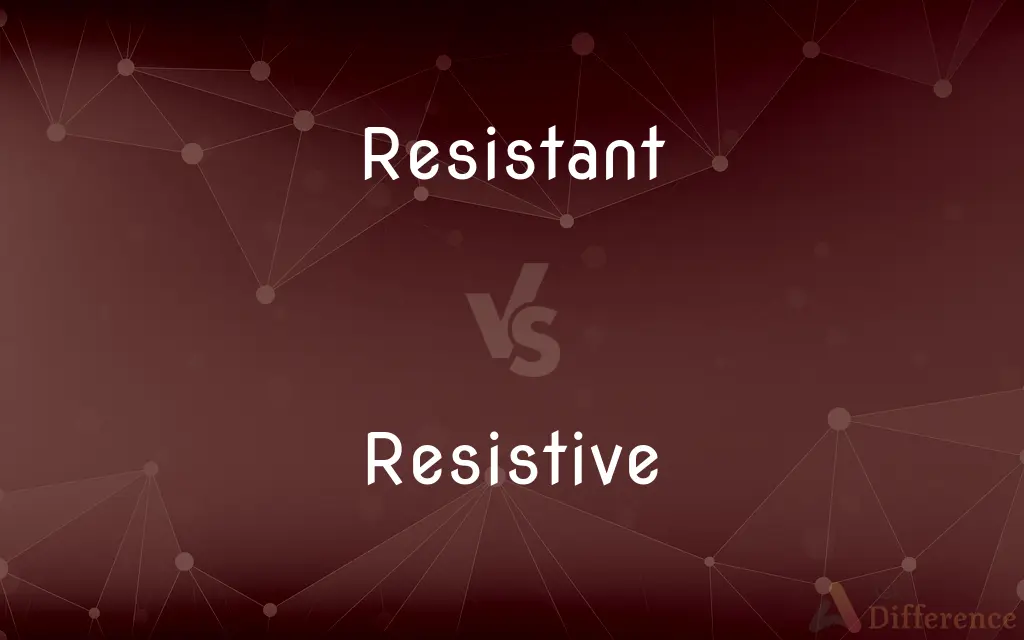Resistant vs. Resistive — What's the Difference?
Edited by Tayyaba Rehman — By Maham Liaqat — Updated on April 2, 2024
Resistant implies the ability to withstand or oppose a force, condition, or treatment, focusing on inherent strength or immunity, while resistive pertains to the property of resisting electric current, emphasizing a material's opposition to flow.

Difference Between Resistant and Resistive
Table of Contents
ADVERTISEMENT
Key Differences
Resistant is used to describe the capability of an organism, material, or structure to withstand or oppose negative effects, such as diseases, chemicals, or physical forces. Whereas, resistive specifically refers to the electrical characteristic of materials that impede the flow of electric current, highlighting a physical property rather than an ability to withstand a broader range of challenges.
The term resistant often implies a natural or developed immunity or tolerance against something harmful or undesirable, such as bacteria being resistant to antibiotics. On the other hand, resistive is a technical term used primarily in physics and engineering to describe how much a material opposes the passage of electrical current, quantified by resistance measured in ohms.
In contexts such as biology or psychology, being resistant can denote an organism's or individual's ability to resist infections, stress, or psychological pressure. In contrast, the concept of resistivity (related to being resistive) is used to calculate the resistance of a material of a specific size and shape, focusing purely on physical and electrical properties.
Materials or substances can be described as resistant based on their ability to maintain integrity or functionality in harsh conditions, such as heat-resistant materials or water-resistant coatings. Conversely, describing something as resistive usually relates to its efficiency in reducing or controlling the flow of electricity, like resistive touch screens or resistive heating elements.
The difference between being resistant and resistive also implies a difference in scope and application: resistance encompasses a broad range of opposition capabilities, from biological immunity to environmental durability, whereas resistivity is a specific physical characteristic relevant to the field of electronics and electrical engineering.
ADVERTISEMENT
Comparison Chart
Definition
Capable of withstanding or opposing something.
Exhibiting resistance to electric current.
Application
Broad (biology, psychology, materials science).
Narrow (physics, electrical engineering).
Measurement
Not quantified in specific units.
Quantified in ohms (Ω).
Implication
Implies immunity, durability, or tolerance.
Pertains to electrical opposition.
Examples
Antibiotic-resistant bacteria, heat-resistant materials.
Resistive touch screens, resistors in circuits.
Compare with Definitions
Resistant
Not easily affected by a disease.
This strain of bacteria has become resistant to antibiotics.
Resistive
Pertaining to resistance in an electrical context.
Resistive heating is used in electric toasters.
Resistant
Showing opposition or unwillingness.
She was resistant to the idea of moving.
Resistive
Having the property of resisting electrical current.
A resistive material reduces current flow in a circuit.
Resistant
Maintaining integrity under adverse conditions.
The material is resistant to both heat and corrosion.
Resistive
Involving the reduction of electrical flow.
Resistive elements in electronics manage the distribution of current.
Resistant
Capable of withstanding harsh conditions.
The plant is resistant to cold weather.
Resistive
Characterized by opposition to electricity.
Resistive sensors measure touch by detecting changes in resistance.
Resistant
Able to oppose something effectively.
The coating makes the fabric resistant to stains.
Resistive
Specific to electrical resistance.
The resistive properties of the wire depend on its material and thickness.
Resistant
Offering resistance to something or someone
Some of the old Churches are resistant to change
A water-resistant adhesive
Resistive
Of, tending toward, or marked by resistance
A person resistive to change.
Resistant
Denoting starch that is not easily broken down by enzymes within the body and is therefore minimally absorbed during digestion
Cooked rice, like bread, contains a useful amount of resistant starch, which acts like fibre in the digestive system
Resistive
(rare) Tending to resist (against something or someone); resistant.
He had a stubborn, resistive nature.
Resistant
Capable of, offering, or showing resistance. Often used in combination
Drug-resistant bacteria.
Wrinkle-resistant pants.
Resistive
(electronics) Acting as a resistor; resisting the passage of electrical current.
This material is highly resistive.
Resistant
One that is resistant, especially a person active in a Resistance movement.
Resistive
(electronics) Of an electronic circuit: consisting only of resistors and power sources; having no inductance and capacitance.
A pure resistive circuit
Resistant
A person who resists; especially a member of a resistance movement.
Resistive
Serving to resist.
Resistant
A thing which resists.
Resistive
Exhibiting or relating to electrical resistance;
Resistive load
Resistant
Which makes resistance or offers opposition.
Resistive
Disposed to or engaged in defiance of established authority
Resistant
Which is not affected or overcome by a disease, drug, chemical or atmospheric agent, extreme of temperature, etc.
The infection is resistant to antibiotics.
Resistant
(statistics) Not greatly influenced by individual members of a sample.
Resistant
Making resistance; resisting.
Resistant
Relating to or conferring immunity (to disease or infection)
Resistant
Incapable of being affected;
Resistant to persuasion
Resistant
Disposed to or engaged in defiance of established authority
Resistant
Incapable of absorbing or mixing with;
A water-repellent fabric
Plastic highly resistant to steam and water
Common Curiosities
What makes a material resistive?
A material's resistive properties are determined by its ability to oppose the flow of electric current, which depends on its physical and chemical structure.
Can a material be both resistant and resistive?
Yes, a material can be both if it can withstand certain conditions (e.g., heat) and also opposes electrical current.
How is "resistive" measured?
Resistive properties are measured in ohms (Ω), indicating the degree to which a material opposes the flow of electric current.
Why is resistance important in biology?
It's crucial for understanding how organisms withstand diseases, adapt to toxins, or survive harsh environmental conditions.
What role does resistance play in product design?
Resistance determines how well a product can withstand environmental stresses or operate under specific conditions, including its electrical functionality.
Why is electrical resistance important in circuits?
It's vital for controlling the flow of current, ensuring devices operate safely and efficiently.
How does temperature affect resistive properties?
Temperature can increase or decrease a material's resistivity, affecting how it opposes electrical current.
How do you increase a material's resistivity?
Increasing resistivity involves altering its composition or structure to more effectively oppose the flow of electricity.
Can resistance change over time?
Yes, resistance can change due to factors like wear, environmental exposure, or adaptation in biological contexts.
What does "resistant" imply in a material?
It implies the material can withstand or remain unaffected by external forces or conditions, such as chemicals, heat, or wear.
Is water resistant or resistive?
Water can be considered resistant to certain substances dissolving in it but is also a resistive medium for electrical current to a degree.
What are resistive screens used for?
Resistive screens are used in devices requiring input through direct pressure, such as touchscreens in industrial controls.
What are the applications of resistive materials?
Resistive materials are used in a variety of applications, including resistors in electronic circuits, heating elements, and touch-sensitive devices.
How do resistant and resistive compare in electrical engineering?
In electrical engineering, resistant may refer to materials' general ability to withstand conditions, while resistive specifically describes opposition to electric current.
Can resistance to antibiotics be overcome?
Overcoming antibiotic resistance requires developing new drugs or treatment strategies that the bacteria have not yet adapted to.
Share Your Discovery

Previous Comparison
Hindi vs. Nepali
Next Comparison
Award vs. AchievementAuthor Spotlight
Written by
Maham LiaqatEdited by
Tayyaba RehmanTayyaba Rehman is a distinguished writer, currently serving as a primary contributor to askdifference.com. As a researcher in semantics and etymology, Tayyaba's passion for the complexity of languages and their distinctions has found a perfect home on the platform. Tayyaba delves into the intricacies of language, distinguishing between commonly confused words and phrases, thereby providing clarity for readers worldwide.
















































